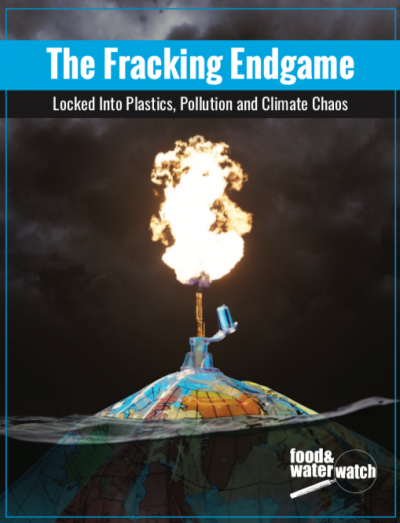The Fracking Endgame: Locked into Plastics, Pollution and Climate Chaos
Executive Summary

In the mid-2000s, the oil and gas industry accelerated the use of the controversial hydraulic fracturing (“fracking”) technique to extract formerly inaccessible natural gas from shale rock and other geologic formations. Fracking has threatened communities near drilling rigs with water pollution, air emissions and ecosystem degradation.
Despite the risks and ecological destruction, fracking has spread like wildfire. Between 2000 and November 2018, the number of gas wells rose by more than half to approximately 550,000 drilling rigs.1 Fracked gas production surged more than 15-fold from 2000 to the first half of 2018 when it reached an average of 56.3 billion cubic feet per day.2 All this additional gas has pushed real, inflation-adjusted natural gas prices to their lowest levels in decades, now 60 percent lower than in 2008.3
Persistently low prices have challenged the economic viability of the fracking industry’s continuous exploration and drilling. The business solution to the oversupply and low prices was to find and promote new industry partnerships to absorb the gas glut, tighten up supplies and raise prices enough to keep expanding fracking’s footprint.
Three industrial partners stepped up to capitalize on low gas prices:
the petrochemical and plastics industries that use natural gas liquids as a key feedstock for their manufacturing; gas exporters building liquefied natural gas (LNG) terminals to ship gas overseas; and natural gas-fired power plants. These industries gain low-priced supplies and form a symbiotically profitable business alliance with the fracking industry.
These industries are rapidly expanding:
- Proliferation of plastics plants to capitalize on fracking: Industry experts project that the plastics industry will have added 28 million tons of plastic production between 2011 and 2020, and more than $202 billion is slated to be invested in 333 new facilities and expansions to take advantage of fracked gas, including 20 ethylene crackers to turn shale gas into feedstock for plastics manufacturing plants.
- Pushing natural gas exports to raise domestic prices: The industry and the Trump administration are promoting LNG exports to reduce the domestic gas supply and raise U.S. natural gas prices. In 2018, there were only 3 active LNG export facilities in the contiguous United States, but 22 more were either already being built or were approved for construction, and another 22 were pending federal review.
- Wave of new fracked gas-fired power plants: The power industry has 364 new gas-fired power plants under development for 2018 to 2022, and gas deliveries to power plants rose 57 percent between 2006 (before the fracking boom) and 2017. The gas-fired generation capacity from plants added in 2017 and 2018 alone could power 24 million U.S. households, an expansion that is creating a power surplus in some areas.
These industries are throwing an economic lifeline to the fracking industry. Without the buildout of fracked gas infrastructure, the fracking industry would likely face more severe economic headwinds and find it more difficult to fund drilling and exploration projects.
But as these industries prop up their mutual profits, they are proliferating pollution. Petrochemical plants, gas liquefaction facilities and gas-fired power plants emit air and climate pollution. Far from being a cleaner power source, natural gas is no climate solution.
The power plants emit greenhouse gases and other hazardous air pollutants, and widespread leaks of potent climate gas methane from gas infrastructure such as pipelines mean that declining power plant emissions are outweighed by increased greenhouse gas emissions from methane leaks.
The United States needs to rapidly shift to 100 percent clean, renewable energy to curb the worst impacts
of climate catastrophe. The fossil fuel infrastructure that is currently planned and under construction will have an effective lifespan far longer than the point when experts agree that the world must shed all fossil fuels, meaning that these stranded assets will be wasted economic investments.4 But the fracking industry’s partnership with the triple threat of the plastics industry, gas exporters and power companies is buttressing the climate-destroying expansion of fracking in the United States.
Read complete Food and Water Watch report here.
*
Note to readers: please click the share buttons above or below. Forward this article to your email lists. Crosspost on your blog site, internet forums. etc.

